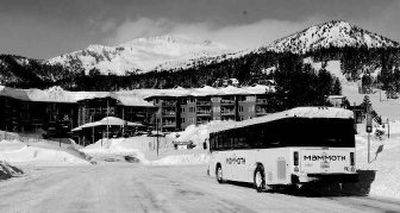Green power gets a lift

STATELINE, Nev. — Mammoth Mountain urges its visitors to park their cars and take advantage of an extensive bus network. The Vail resorts, including nearby Heavenly at Lake Tahoe, run their lifts with wind power. In Colorado, the Sunshine Express high-speed quad at Steamboat operates on sunlight.
The ski industry is going green to help offset the pollution that feeds global warming — a phenomenon that challenges the resorts’ very existence with the threat of later snowfalls and earlier snow melts.
Fifty-five resorts in 14 states are buying renewable energy to offset part or all of their power needs, according to the National Ski Areas Association. Of these, 26 are operating 100 percent on green energy.
“We as a company and us as an industry are really kind of leading the way amongst corporate America in doing the right things for the environment,” Vail Resorts CEO Rob Katz said.
Vail Resorts took the environmental lead in August with the purchase of nearly 152,000 megawatt hours of wind energy, making it the second largest corporate user in the United States, behind Whole Foods Market Inc. Wind powers every lift and light bulb (low energy) at Vail’s five resorts — Vail, Beaver Creek, Arrowhead and Keystone in Colorado and Heavenly in the Sierra on the California-Nevada line.
Vail trumped its own environmental card earlier this month with the announcement of plans for Ever Vail, one of the largest green projects at a North American ski resort. The $1 billion development will total about 1 million square feet including condos, a hotel and commercial buildings. Katz hopes it will win certification from the Leadership in Energy and Environmental Design system, or LEED, which promotes buildings that use less energy and water, emit less pollution and conserve materials.
Colorado Wild, a Durango-based environmental group, has been critical of Vail and other resorts, saying that while they are investing in alternative energy, they don’t always protect wildlife habitat and water.
“The first question that always needs to be asked is whether or not additional development is necessary at all,” spokesman Ryan Bidwell said.
Katz said there always will be folks who are quick to point out what more can be done, and he said there is a role for that.
“I appreciate all the feedback we get from some of the environmental groups and, frankly, we do use some of that feedback and the feedback we get from our employees, our guests in figuring out what our next environmental step should be. But we’re not going to try to fix everything or launch everything all at one time … That’s always a recipe for disaster.”
At Mammoth, Environmental Program Director Lisa Isaacs said her job goes beyond making sure the resort follows the rules.
“I’m not driven by regulatory compliance. Being in compliance is the lowest common denominator for us. We need to go way beyond compliance,” she said.
In addition to her job developing policies that encourage employees and guests to conserve, the resort also has an energy manager — Bob Bradbury — who goes by the nickname “Tight Watt.”
From things as simple as scraping ice out of doorways so the doors close tightly to more complex ones like monitoring buildings with an infrared camera to detect heat leaks, Bradbury helps Mammoth save energy — and money. The resort has had bus service since 1984 to get visitors out of their cars, starting with 170,000 passengers the first season and expanding to more than 700,000 last year.
“It’s in the very nature of, especially with high profile companies, to want to do something splashy and big and sexy,” Isaacs said. “Auditing your buildings and tightening up your energy use is not splashy, big and sexy. But a way to reduce greenhouse gases is by conserving energy.”
There’s no consensus among scientists that greenhouse gases produced by burning fossil fuels are wholly responsible for global warming. Nevertheless, the symbolic Doomsday Clock, first set at 11:53 p.m. in 1947, at the beginning of the Cold War, was moved to five minutes before midnight in January. For the first time, scientists who oversee the clock cited the threat of climate change along with nuclear standoffs with Iran and North Korea for pushing the clock’s hands two minutes closer to midnight.
Threatened by a potential doomsday of its own, the ski industry has responded on several fronts to both green up and to conserve.
High-speed lifts and gondolas carry more passengers and whisk them to the top of the mountain faster than their predecessors. Some resorts are switching over to biodiesel — fuel from renewable sources such as vegetable oils and animal fats — to power their shuttles or to hybrid vehicles.
“We’re probably going to raise around $600,000 a year and although there’s probably less glitz in that type of a program, there will probably be more impact locally and to the environment right away from those efforts,” Katz said.
“It’s about doing the right thing for the environment and doing the right thing for our guests. We really think that all these projects that we’re doing are things that are really consistent with what our guests want. We obviously think that that’s paid off in spades down the road from having greater loyalty from our guests,” he said.